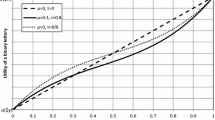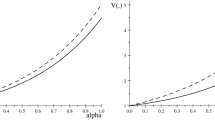Abstract
Among the violations of expected utility (E.U.) theory which have been observed by experimenters, the violations of its independence axiom is, by far, the most common. It seems that, in many cases, these inconsistencies can be ascribed to the desire for security - called the security factor by L. Lopes (1986) - which “makes people attach special importance to the worst outcomes of risky decisions” as well as to the sole outcomes of riskless decisions (certainty effect). J.-Y. Jaffray (1988) has proposed a model which generalizes E.U. theory by taking into account this factor and is then able to account for certain violations. However, especially in experiments on choice involving prospective losses, violations of the von Neumann-Morgenstern independence axiom cannot be explained by the security factor alone and have to be partially ascribed to the potential factor (L. Lopes, 1986) which “reflects heightened attention to the best outcomes of decisions”, especially when the best outcome is the status quo. In this paper, we construct an axiomatic model for subjects taking into account simultaneously or alternatively the security factor and the potential factor. For this, as in Jaffray's model, it has been necessary to weaken not only the standard independence axiom but also the continuity axiom and, in the same time, to reinforce the dominance axiom. In the resulting model, choices are partially determined by the mere comparison of the (security level, potential level) (i.e. the (worst outcome, best outcome)) pairs offered, and completed by the maximization of an affine function of the expected utility, the coefficients of which depend on both the security level and potential level.
In this model, a decision maker who (i) has constant marginal utility for money, (ii) is sensitive to the security factor alone in the domain of gains, (iii) is sensitive to the potential factor alone in the domain of losses, behaves as a risk averter for gains and a risk seeker for losses.
Similar content being viewed by others
References
Allais, M.: 1952, ‘The Foundations of a Positive Theory of Choice Involving Risk and a Criticism of the Postulates and Axioms of the American School’, (Translation of ‘Fondements d'une Théorie Positive des Choix Comportant un Risque et Critique des Postulats et Axiomes de l'Ecole Américaine’, Paris, CNRS) in Allais and Hagen (Eds.), Expected Utility Hypotheses and the Allais Paradox, Dordrecht, Holland (1979).
Battalio, R., Kagel, J., and Jiranyakul, K.: 1990, ‘Testing Between Alternative Models of Choice Under Uncertainty: Some Initial Results’, Journal of Risk and Uncertainty, 3, 25–50.
Camerer, C.: 1989, ‘An Experimental Test of Several Generalized Utilities Theories’, Journal of Risk and Uncertainty, 2, 61–104.
Chew, S. H.: 1983, ‘A Generalization of the Quasilinear Mean with Applications to the Measurement of Income Inequality and Decision theory Resolving the Allais Paradox’, Econometrica, 51, 1065–1092.
Cohen, M. and Jaffray, J. Y.: 1988, ‘Certainty Effect vs. Probability Distortion: An Experimental Analysis of Decision Making Under Risk’, Journal of Experimental Psychology, H.P.P., 14(4), 554–560.
Conlisk, J.: 1989, ‘Three Variants on the Allais Example’, American Economic Review, 79, 392–407.
Gilboa, I.: 1989, ‘A Combination of Expected Utility and Maxmin Decision Criteria’, Journal of Mathematical Psychology.
Herstein, I. and Milnor, J.: 1953, ‘An Axiomatic Approach to Measurable Utility’, Econometrica, 21, 291–297.
Hey, J. and Strazzera, E.: 1989, ‘Estimation of Indifference Curves in the Marschak-Machina Triangle: A Direct Test of the “Fanning Out” Hypothesis’, Journal of Behavioral Decision Making, 2, 239–260.
Jaffray, J. Y.: 1989, ‘Some Experimental Findings on Decision Making Under Risk and their Implications’, European Journal of Operations Research, 38, 301–306.
Jaffray, J. Y.: 1988, ‘Choice under Risk and the Security Factor: An axiomatic model’, Theory and Decision, 24(2).
Jensen, N. E.: 1967, ‘An Introduction to Bernoullian Utility Theory I: Utility Functions’, Swedish Journal of Economics, 69, 163–183.
Kahneman, D. and Tversky, A.: 1979, ‘Prospect Theory: An Analysis of Decision Under Risk’, Econometrica, 47, 263–291.
Karmarkar, U.: 1974, The Effect of Probabilities on the Subjective Evaluation of Lotteries, Massachussetts Institute of Technology, Sloan School of Management, Working Paper No. 698-74.
Lopes, L. L.: 1986, Between Hope and Fear: The Psychology of Risk, Advances in Experimental Social Psychology.
McCord, M. R. and de Neufville, R.: 1984, ‘Utility Dependence on Probability: an Empirical Demonstration’, Journal of Large Scale Systems, 6, 91–103.
McCrimmon, K. and Larsson, S.: 1979, ‘Utility Theory: Axioms Versus “Paradoxes”,’ in Allais and Hagen (1979).
Machina, M.: 1982a, ‘“Expected Utility”, Analysis without the Independence Axiom’, Econometrica, 50, 277–323.
Machina, M.: 1983, ‘Generalized Expected Utility Analysis and the Nature of Observed Violations of the Independence Axiom’, Foundations of Utility and Risk Theory with Applications, Stigum and Wenstop (Eds.).
Machina, M.: 1987, ‘Choice under Uncertainty: Problems Solved and Unsolved’, Economic Perspectives, 1(1).
Munier, B. and Abdellaoui, M.: 1991, ‘Expected Utility Violations: An Appropriate and Intercultural Experiment’, in New Developments in Risk and Utility Theory in A. Chikan (Ed.), Proc. of FUR IV Conference, Budapest, Kluwer Academic Publishers, Dordrecht, Boston
de Neufville, R. and Delquie, P.: 1988, ‘A Model of the Influence of Certainty and Probability “Effects” on the Measurement of Utility”, in Risk Decision and Rationality, B. Munier (Ed.), pp. 189–205.
Quiggin, J.: 1982, ‘A Theory of Anticipated Utility’, Journal of Economic Behavior and Organization, 3, 323–343.
Schoemaker, P.J.: 1980, ‘Experiments on Decisions Under Risk. The Expected Utility Hypothesis’. Martin Nijhoff Publishing, Boston.
Segal, U.: 1989, ‘Anticipated Utility: A Measure Representation Approach’, Annals of Operations Research, 19, 359–373.
Von Neumann, J. and Morgenstern, O.: 1944, Theory of Games and Economic Behavior, Princeton University Press, Princeton (Second Edition, 1947, Third Edition, 1953).
Yaari, M. E.: 1987, ‘The Dual Theory of Choice Under Risk’, Econometrica, 55(1).
Author information
Authors and Affiliations
Rights and permissions
About this article
Cite this article
Cohen, M. Security level, potential level, expected utility: A three-criteria decision model under risk. Theor Decis 33, 101–134 (1992). https://doi.org/10.1007/BF00134092
Issue Date:
DOI: https://doi.org/10.1007/BF00134092




